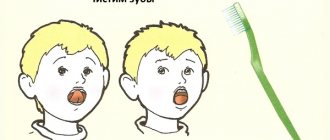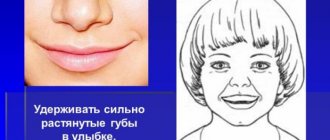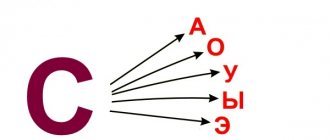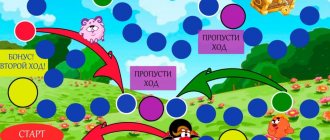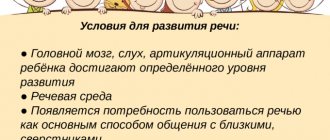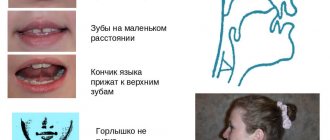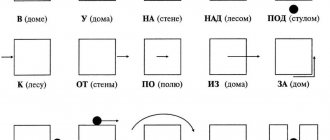Age of the child and readiness of the speech apparatus
If a 3-4 year old child does not pronounce the sound and the letter CH, this is still within the normal range, since the articulation of the sound [CH] is complex:
- the tip of the tongue rises to the palate, bending like a hook so as to touch the alveoli of the upper teeth from the inside;
- for a short moment it sticks to the roof of your mouth;
- then the entire body of the tongue sharply falls down.
Such complex articulation of the sound [H] is available to children from 5 years old. The child is ready to pronounce it if he has already mastered the sounds [ZH], [SH] and [SH].
Listen to the sound formation [H] and you will hear that the sound consists of soft [t'] and sharp [uh'].
Sound characteristics [H]:
The sound [CH'] is consonant, dull, always soft.
How to distinguish between hard and soft sounds
If after a consonant sound E, Yo, Yu, Ya or I is written, then this consonant is soft. For example:
- [m']: change, honey, muesli, ball, bowl, place, meat, mules;
- [s']: gray hair, salmon, surrealism, sit down, strength, heart, cigarette, village;
- [d']: day, der, dune, woodpecker, dinosaur, tree, dynasty, demon.
If a soft sign is written after a consonant sound, then this consonant is classified as soft. Examples:
- [n']: ripple, individual, ice hole, dove, spear;
- [n']: laziness, fear, stump, greens, fire;
- [s']: ligature, carving, air communication, elk, casually.
If after a consonant sound there is a consonant that influences the previous sound, then this consonant is soft. Let's look at examples:
- [n']: umbrella (influences [t']), scholarship (influences [d']).
- [s']: bridge (influences [t']), conscience (influences [t']), guest (influences [t']).
These rules do not apply to the letters Ж, Ш, Ц.
Sound setting [h]
The articulation of the sound [H] can be set in 3 ways:
- Using part [t']: pronounce this sound at a very fast pace so that the tip of the tongue reaches the base of the upper incisors from the side of the palate. Then begin to wrap it, as if stroking the tubercle at the roots of the teeth - the alveoli. And at the same time you need to stretch the corners of your mouth wide, as if in a smile.
- Using two components [t'] and [sch']: smiling widely, first slowly, and then faster and faster, pronounce alternately [t'] and [sch']. Speed allows them to merge and achieve clear articulation of sound.
- Explain sound formation by breaking down the process into stages: for the exercise you need a piece of paper or a chocolate bar. It rests on the tip of the tongue and the child is asked to stick it over the hole, which is located between the upper incisors on the inside. To do this, you must first feel this place, and then send your tongue on a “task” with a piece of treat. To fix chocolate or paper, you need to apply force, which will serve as articulatory gymnastics and allow you to automate the movement of the tongue.
In all cases, it is necessary to sit the child in front of a mirror and focus on ensuring that he follows his movements in the reflection. Some parents ignore this rule, but speech therapy sessions are much more productive with visual control of the positions of the mouth and tongue.
Correct articulation of the sound Ch
When articulating the sound H, the speech apparatus is in the following positions:
- The lips are rounded and moved forward slightly.
- The teeth don't connect.
- The tip of the tongue, without straining, connects with the upper teeth. There should be a small gap between the tongue and teeth.
- There is a flow of air in the middle of the tongue, which is clearly felt when you bring your palm to your mouth.
- The soft palate rises and presses against the back wall of the pharynx, while the passage into the nasal cavity closes, air passes through the mouth.
- The vocal folds do not tense, nor do they move apart.
Articulation gymnastics
First, you need to “warm up” your tongue, because this organ is a large muscle. Here are some exercises to help prepare her for work:
- “Cleaning your teeth”: you need to run your tongue along the inside of your upper teeth. This needs to be done at increasing speed. It is important that it comes into contact with the base of the teeth - the place where they meet the gum. This is where the alveoli are located.
- “Mushroom”: this task will help those children who had problems with other sounds due to a short frenulum. The baby needs to stretch his lips in a smile and press his wide tongue against the upper palate. The wider the mouth is open, the better the result.
- “Sweets”: put toffee or chocolate on the tip of your tongue and stick it to the upper palate near the front teeth. It is important to keep your mouth wide open. Unlike the sound production exercise, the child does not need to pronounce it, because the task is to strengthen the muscle.
If the child likes to do this, then it can be placed at the end of the articulation block and from there move on to pronouncing the sound [Ch]: first, the exercise is without sound, and then it is complicated by the need to pronounce [Ch].
Unpaired hard and soft sounds
Some sounds do not have a pair of hardness and softness.
Always solid are:
- [f]: life, wife, pity, belly, bug, cruelty, honeysuckle;
- [w]: seam, screen, wool, noise, fly, tire, showman;
- [ts]: heron, chicory, tsunami, goal, circus, value, queen.
Always soft are:
- [th']: iodine, yoga, yogurt;
- [u']: puppy, brush, shield, pike, sorrel, tongs, goldfinch;
- [h']: stalk, child, reading, chips, servants, couple, feeling.
We see that the sound [h'] is always soft.
Correct articulation
The exercises described above clearly demonstrate that the production of the sound [H] is possible in several ways, which differ in the method of sound production:
1. Use of a reference sound and correct placement of successive movements of the tongue:
- The baby is asked to always pronounce soft [t'] and at the same time concentrate on ensuring that the tongue is tightly adjacent to the alveoli. Then the specialist shows how to curl the tongue towards the larynx from this position. A spatula is used for this. If the isolated sound [t'] is difficult for him, you can replace it with [at'];
- the child is asked to say [t'] and at the same time press the corners of his mouth with his fingers, stretching his lips out like a tube. With this position of the lips, the tongue automatically slides back.
2. Using the effect of merging parts [H]:
- you need to ask the baby to consistently but quickly pronounce the hard voiceless [t], followed by [sch]. At first this is done slowly, and then with increasing tempo of acceleration. It is important that the pronunciation is formed while exhaling.
3. Exercise using a playful form of imitation:
- imitate the chirping of a grasshopper or “call” ducks – “kacha-kacha”;
- read poetry to the child: the adult reads the lines and pauses in those places where the child should utter a sound.
4. Use reference sounds:
- ask to pronounce the sound “t”, focusing on the correct position of the tongue. As the child pronounces, accompany the sound formation with the movement of a bending palm.
It is difficult for a non-specialist to determine which method is suitable for a child. To do this, parents can alternately use each of these exercises. Based on the results of the work, its effectiveness is assessed. The main thing is not to stop at the fact that the child can differentiate the sounds [t'] and [h], because the articulatory skill has not yet been consolidated.
Corrective work on sound [h]consultation on speech therapy on the topic
Articulation of sound [H]
Features of articulation
The lips are slightly pushed forward and rounded. The tip of the tongue touches the palate (behind the tubercles). The lateral edges of the tongue are pressed tightly against the upper molars. The back of the tongue is raised. Under the pressure of exhaled air, the tip of the tongue comes off the palate. The vocal cords are resting, the throat is not trembling (no voice).
Characteristic
The sound [CH'] is consonant, dull, always soft. The sound is indicated in green.
Initially, it is necessary to test the possibility of producing a sound by ear, by imitation (see articulation of sound [H]). If the sound by imitation does not work, you need to move on to a set of exercises.
Preparatory exercises
Pronouncing a sound that imitates the sound [T]
- Open your mouth. Place the tip of the tongue against the alveoli (but not against the upper teeth!). The teeth are open to the width of a finger. The lips are open and tense, the corners of the lips are slightly stretched.
Inhaling, blow the air forcefully. In this case, the tip of the tongue sharply rebounds from the alveoli, and the edges of the tongue move away from the upper molars. A dull, hard sound is heard, imitating the sound t. Either slowly or quickly pronounce this imitating sound. The pronunciation of the normal sound t differs from the imitating one in that the tip of the tongue rests on the upper front teeth.
To avoid mistakes, do not turn on your voice. On the palm of your hand you feel a warm stream of air coming out with a push.
- Repeat the previous exercise with slightly rounded lips and teeth closer together.
Pronouncing the sound [H], transitional from the sound imitating the sound [T]
- Open your mouth. Raise the tip of the tongue towards the alveoli. Press the side edges of the tongue tightly against the upper teeth (suck the tongue to the roof of the mouth). In order for the tongue to stick to the palate, the “clack” exercise is useful.
The teacher uses his thumb and forefinger to press (from bottom to top) on the edges of the child’s tongue. A stretched “frenulum” is visible between the fingers. Taking a deep breath, with a strong exhalation push, pronounce a sound imitating the sound t. The sound ch will be heard. The edges of the tongue should not come off the upper molars and weaken. The air comes out in the middle of the tongue when the tip of the tongue bounces sharply off the alveoli.
The distance between the teeth in the exercise is equal to the width of your finger. The teeth are not covered by the lips.
- Repeat the exercise with your fingers, but on your own.
- Perform the exercise without using your fingers. In the exercise, the teeth are brought together, the lips are pushed forward and rounded.
Note. It is allowed to pronounce (read) syllables and words using fingers. When reading words, fingers are used only to pronounce syllables with the sound [CH].
The sound [Х] is colored green (soft consonant). Vowel sounds are colored red.
The sound [CH_] is pronounced for a long time (see articulation of the sound [CH]).
1) Pronounce (read) syllables with the sound [CH_]
Sample: ach__, och__, uch__, ych__, ech__, ich__, ech__, ech__, yuch__, ych__
2) Pronounce (read) words with the sound [Ч'] at the end
Sample: ball
|
|
|
|
|
3) Pronounce (read) words with the sound [Ч'] in the middle
Sample: stove
|
|
|
|
4) Pronounce (read) syllables with the sound [H]
Sample: ch__a, ch__e, ch__o, ch__y, ch__i, ch__e
5) Pronounce (read) words with the sound [Ч'] at the beginning
Sample: tea
|
|
|
|
|
6) Pronounce (read) words with the sound [Ч'] in the middle
Sample: tu-ch__a, ko-ch__an
|
|
|
|
|
7) Pronounce (read) phrases
Sample: Juicy ka-chan.
- Mighty oak.
- The fourth boy.
- Black bangs.
- Honest boys.
- Prickly hedgehog.
- Dark night.
- Start reading.
- Four grandchildren.
- Pump some water.
- Black rooks.
- Hot kettle.
- Golden Key.
- Silent student.
 Conjugate sentences
Conjugate sentences
- I'm learning a rhyme.
- I'm reading a textbook.
- I type on a typewriter.
- I'm swinging on a swing.
Sample:
- I'm treating a bunny.
- You are treating a bunny.
- He (she) treats the bunny.
- We are treating the little bunny.
- You are treating a bunny.
- They are treating the little bunny.
9) Say (read) sentences
Sample: There is a hot pot in the stove.
- The girls have balls.
- Olechka was cured by a doctor.
- Helen plays with the ball.
- The boys run to the river.
- The boy has brown gloves.
- The bug growled in the booth.
- The calf drinks some water.
- The boy bought a roll of bread and cookies at the bakery.
- Children catch bugs, butterflies and grasshoppers.
- The students learned from textbooks.
- The boy has a turtle.
- Seagulls were screaming at the pier.
- This morning, a noisy flock of rooks flew to us.
- The boys are chewing rolls by the stove.
- The hedgehog is very prickly.
- Rooks carry larvae and worms.
- The little black one growled at the boy.
- The boys were swinging on a swing.
- There is a wheelbarrow without a handle in the garden.
- The girl dropped the ball.
- The hen laid an egg.
- Ninochka is a neat girl.
- A butterfly flew into the window.
- The squirrel jumped onto the Christmas tree.
- Tanya ate a bun and washed it down with milk.
- Wind, wind, you are powerful, you drive flocks of clouds.
- Olechka got scared and sat quietly.
- Everywhere you look there are dandelions, like little light bulbs.
- The pines are small, but there are birds on the pines.
- Zina has bugs, spiders and various insects in her box.
- The wild strawberry has a small sprout.
10) Pronounce (read) pure sayings
- Cho-cho-cho, cho-cho-cho - my shoulder hurts. Chu-chu-chu, chu-chu-chu - if it hurts, go to the doctor. Chu-chu-chu, chu-chu-chu - no, I don’t want to see a doctor. Cha-cha-cha, cha-cha-cha - I’ll cry at the doctor’s. Chi-chi-chi, chi-chi-chi - the doctors are helping us. Chu-chu-chu, chu-chu-chu - well, then I’ll go to the doctor.
- The turtle, not bored, sits for an hour with a cup of tea.
- Petya has a car, and Pashechka has a packet of cookies.
- The baker was baking kalachi in the oven. The rolls are hot from the oven.
- A sheep's fur coat is warmer than any stove.
- The river flows and the stove bakes.
- Titmouse, titmouse - sister to the sparrow.
- Hot bricks! Get off the oven, bake some rolls of flour in the oven!
11) Pronounce (read) and retell the text
Teen Wolf
There lived a mother wolf and a wolf cub. The wolf went hunting. And the wolf cub was caught by a man. The man carried the wolf cub home in a sack. At home, he put the bag with the wolf cub on the floor. The wolf cub got tired of lying in the bag, and he got out. And towards me is a cat. The wolf cub ran back. And the bag lies like a rag. The wolf cub ran towards the man. The man put the wolf cub in a box. The cat won't touch him there. The man left and did not close the door tightly. The wolf cub quietly crawled out. He came up and opened the door. The wolf cub ran along the road, and there the wolf was already waiting for him. The wolf cub was delighted and rushed with her into the forest.
(According to E. Charushin)
12) Pronounce (read) and memorize a poem
Meeting
A bull met a hedgehog and licked his side. And, having licked it, it’s in the side. He pricked his tongue. And the prickly hedgehog laughs: “Don’t put anything in your mouth!”
Sound automation [h]
To automate pronunciation, the following sequence of exercises is used:
- first pronouncing direct and then reverse syllables: cha-ach, uch-chu, cho-och;
- pronouncing one- and two-syllable words with [h] at the end: ball, game, bulls, bird;
- pronunciation of words where the sound is in the middle: barrel, duck, spiders;
- pronouncing words that begin with [h]: teapot, cast iron, Chukotka;
- reading or pronouncing phrases with sound, pairing them: tea cups, leather suitcase, stump-stump, cat-cat.
- pure phrases and poems saturated with this sound are the final part of speech therapy work on automation.
Automation of the sound [h] in straight syllables
Automation of the sound [h] in reverse syllables
Automation of sound [h] in words
Automation of sound [h] in phrases and sentences
Automation of sound [h] in pure language
Automation of sound [h] in poems
Exercises to develop exhalation
- The baby stands with his feet shoulder-width apart. While inhaling, he spreads his arms with his nose, while exhaling, he squats and hugs himself with his arms.
- Starting position is the same as in the previous exercise. Connect your hands in a “lock”, they are at the bottom. As you inhale, your arms rise up, while your breath is held. Then exhale very slowly, lowering your hands and saying “uh.”
- Puff out your cheeks to the maximum, hold for half a minute. Then pull your cheeks in and hold again for the same amount of time.
- Sit on a chair. Slowly lower and raise your hands, saying “Kaar”.
- Game-competition. Children compete to see who can growl the longest in one breath. (You can also compete to see who can hum the longest while exhaling.)
Differentiation of sounds [h]-[t], [h]-[ts], [h]-[sch],
The problem of separation of sounds [h]-[t] is typical for children who are learning to pronounce this sound in one language. The differentiation of sounds [ts]-[h]” and [h]-[h] is relevant for children from bilingual families. This replacement is typical for foreign languages of the Altai family.
For differentiation, the child is asked to pronounce syllables, words, phrases, sentences containing the sounds [h]-[t], [h]-[ts], [h]-[sch].
Differentiation of sounds [h]-[t] in syllables
Differentiation of sounds [h]-[t] in words
Differentiation of sounds [h]-[t] in words
Differentiation of sounds [h]-[t] in words
Differentiation of sounds [h]-[t] in riddles
Differentiation of sounds [h] - [t] in poetry
Differentiation of sounds [ch] - [ts] in syllables
Differentiation of sounds [ch] - [ts] in words
Differentiation of sounds [ch]—[ts] in phrases
Differentiation of sounds [ch] - [ts] in poetry
Differentiation of sounds [h]—[w'] in syllables
Differentiation of sounds [h]—[w'] in words
Differentiation of sounds [h]—[w'] in texts
Differentiation of sounds [h]—[w'] in poetry
Classes on production, automation and differentiation of sound [h] are recommended to last up to 10 minutes for children 4-5 years old and up to 20 minutes for 6-7 year olds.
Paired hard and soft sounds
Almost all sounds have a pair of hardness and softness. Let's make sure of this:
- song [n'] – flow [n];
- earth [z'] – heat [z];
- battle [b'] – battle [b];
- kilometer [k'] – blood [k];
- family [s'] – word [s];
- dream [m'] – frost [m];
- ignorance [n'] – norm [n];
- heroism [g'] – bunch [g];
- hairdryer [f'] – felt-tip pen [f];
- shipyard [v'] – theft [v];
- shadow [t'] – brake [t];
- sharpness [r'] – novel [r];
- childhood [d'] – road [d];
- downpour [l'] – breakdown [l];
- chemistry [x'] – rudeness [x].
